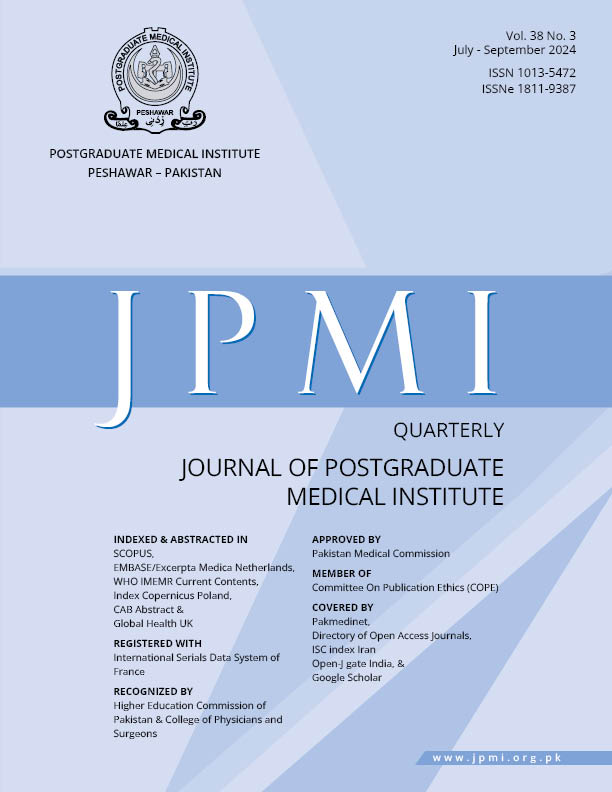Evaluation of Nose Morphology in Different Skeletal Patterns in Patients Reporting to Tertiary Care Hospital at Peshawar, Pakistan: A Cross-Sectional Study.
Main Article Content
Abstract
Objectives: This study aims to evaluate the relationship between nasal parameters and sagittal skeletal malocclusions while considering gender differences.
Material and Method: A calculated sample size of 75 adult subjects was included in this cross-sectional study based on inclusion criteria of age between 16-30 years seeking orthodontic treatment. Nasal parameters were evaluated clinically using the nasal index, classifying noses into three shapes: Leptorhinne, Platyrhinne, and Mesorhinne. Skeletal malocclusions were categorized as Class I, Class II, or Class III based on the ANB angle on the lateral cephalogram. Statistical tests included chi-square tests and post-stratification chi-square tests to explore the correlation between nose morphology, gender, and skeletal malocclusions.
Result: The sample size comprises 56% females and 44% males. There was no significant relationship between skeletal malocclusion and nose shape. One-way ANOVA indicated significant differences in Nose Depth (p value 0.031*) and Horizontal Distance between PRN and STPog parallel to HP (p value 0.000*) among skeletal malocclusion groups. Post hoc analysis confirmed significant variations in Nose Depth and Horizontal Distance between specific malocclusion groups. However, no significant differences were observed in Upper Nose Length, Nasal Height, or Lower Nose Length among these groups.
Conclusion: The nose shape has no relation to skeletal malocclusion and gender of subjects. Skeletal Class III has more deeper nose depth as compared to Class II malocclusion. Horizontal distance was greater in Skeletal Class II malocclusion in comparison to Class I and Class III malocclusion.
Article Details
Work published in JPMI is licensed under a
Creative Commons Attribution-NonCommercial 2.0 Generic License.
Authors are permitted and encouraged to post their work online (e.g., in institutional repositories or on their website) prior to and during the submission process, as it can lead to productive exchanges, as well as earlier and greater citation of published work.
References
Phillips C, Proffit WR. Psychosocial aspects of dentofacial deformity and its treatment. Contemporary treatment of dentofacial deformity. St. Louis: Mosby. 2003:69..
Sahoo R, Parihar AV, Chaturvedi TP, Verma S. Relationship of Nasal Morphology With Different Dentoskeletal Patterns: A Systematic Review. Journal of Indian Orthodontic Society. 2021 Apr;55(2):122-37.
Jankowska A, Janiszewska-Olszowska J, Grocholewicz K. Nasal Morphology and Its Correlation to Craniofacial Morphology in Lateral Cephalometric Analysis. International Journal of Environmental Research and Public Health. 2021 Jan;18(6):3064.
Proffit, W.R. The Etiology of Orthodontic Problems. In Contemporary Orthodontics, 6th ed.; Proffit, W.R., Fields, H.W., Larson, B., Sarver, D.M., Eds.; Elsevier Health Sciences: Philadelphia, PA, USA, 2018; pp. 107–140. [Google Scholar]
Ochoa, B.K.; Nanda, R.S. Comparison of maxillary and mandibular growth. Am. J. Orthod. Dentofac. Orthop. 2004, 125, 148–159. [Google Scholar] [CrossRef]
Ogoun TR. Nose Pattern of Ekowe Indigenes, Bayelsa State. Sch Int J Anat Physiol. 2021;4(10):169-72.
Robison JM, Rinchuse DJ, Zullo TG. Relationship of skeletal pattern and nasal form. American journal of orthodontics. 1986 Jun 1;89(6):499-506.
Park J, Suhk J, Nguyen AH. Nasal analysis and anatomy: Anthropometric proportional assessment in Asians—aesthetic balance from forehead to chin, part II. InSeminars in plastic surgery 2015 Nov (Vol. 29, No. 04, pp. 226-231). Thieme Medical Publishers.
Zaidi AA, Mattern BC, Claes P, McEcoy B, Hughes C, Shriver MD. Investigating the case of human nose shape and climate adaptation. PLoS genetics. 2017 Mar 16;13(3):e1006616.
Jabeen N, Magotra R, Choudhary S, Sharma AK. Study of nasal index in different zones of Jammu and Kashmir. JK Science. 2019 Apr 1;21(2):72-5.
Skinazi GL, Lindauer SJ, Isaacson RJ. Chin, nose, and lips. Normal ratios, in young men and women. American journal of orthodontics and dentofacial orthopedics. 1994 Nov 1;106(5):518-23.
Hwang HS, Kim WS, McNamara Jr JA. Ethnic differences in the soft tissue profile of Korean and European-American adults with normal occlusions and well-balanced faces. The Angle Orthodontist. 2002 Feb;72(1):72-80
Arshad T, Shaikh A, Fida M. Comparison of nasal profiles in various skeletal patterns. Journal of Ayub Medical College Abbottabad. 2013;25(1-2):31-5.
SPSS I. IBM Corp. Released, Statistics for Windows, Version 25.0. Armonk, NY: IBM Corp.
Burstone CJ. The integumental profile. American journal of orthodontics. 1958 Jan 1;44(1):1-25.
Palma P, Bignami M, Delù G, De Bernardi F, Castelnuovo P. Rhinoplasty for the Mediterranean nose. Facial plastic surgery. 2003;19(03):279-94.
Posen JM. A longitudinal study of the growth of the nose. American journal of orthodontics. 1967 Oct 1;53(10):746-56.
Shrestha O, Bhattacharya S, Jha N, Dhungel S, Jha CB, Shrestha S, Shrestha U. Cranio facial anthropometric measurements among Rai and Limbu community of Sunsari District, Nepal. Nepal Med Coll J. 2009 Sep 1;11(3):183-5.
Sarun K, Sandip S, Laxman K. Nasal index of the Tharu and Mongoloid population of Nepal: a cross sectional study. Russian Open Medical Journal. 2014;3(3):302.
Makaju S, Adhikari S, Rai CK. Measurement of nasal index in Bhaktapur region: a descriptive cross-sectional study. Journal of Chitwan Medical College. 2022 Mar 15;12(1):53-6.
Bajracharya M, Sharma S. Nasal index among students of People’s Dental College and Hospital. Europasian Journal of Medical Sciences. 2019;1(1):21-7.
Shrestha R, Manandhar B, Upadhyay HP, Madhikarmi NL. Mean nasal index of dental students of a dental college in Nepal. JNMA: Journal of the Nepal Medical Association. 2019 Apr;57(216):88.
Sudikshya KC, Shrestha S, Bhattarai L. Nasal parameters and facial index in medical undergraduates: a cross sectional study. Journal of Lumbini Medical College. 2019 Dec 30;7(2):81-7.
Rathi S, Gilani R, Kamble R, Vishnani R. Analysis of Nasal Morphology in Skeletal Class I and Skeletal Class II Malocclusion: An Observational Study. Cureus. 2022 Sep 26;14(9).
Dhulqarnain AO, Mokhtari T, Rastegar T, Mohammed I, Ijaz S, Hassanzadeh G. Comparison of nasal index between Northwestern Nigeria and Northern Iranian populations: an anthropometric study. Journal of Maxillofacial and Oral Surgery. 2020 Dec;19:596-602.


